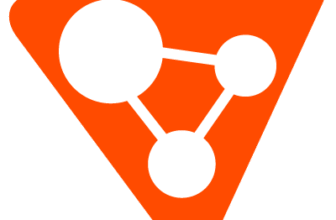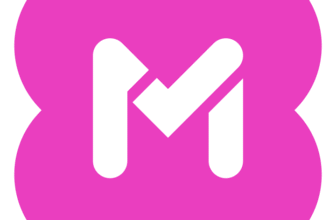
Introduction
Project management is a complex discipline that requires meticulous planning, coordination, and execution. To ensure project success, organizations often establish a Project Management Office (PMO) to oversee and support project-related activities. But what does PMO stand for? In this article, we delve into the meaning of PMO, its role within an organization, and the value it brings to project management endeavors. Join us on this journey as we explore the intricacies of PMO and shed light on its significance in achieving project success.
PMO Meaning: Unveiling the Definition
A Project Management Office (PMO) is a centralized department within an organization that defines and maintains project management standards. It ensures that projects are executed consistently and align with the company’s strategic objectives. By offering guidance, best practices, and standardized processes, a PMO enhances the efficiency and effectiveness of project delivery.
The Evolution of PMOs: From Supportive to Strategic
Initially, PMOs were primarily established to provide administrative support to project managers. However, over time, their role has evolved, expanding into a more strategic function. Modern PMOs now play a pivotal role in aligning project objectives with overall business goals, ensuring efficient resource allocation, and implementing best practices across projects and portfolios.
Structures
PMOs can have different structures based on the organization’s size, industry, and project complexity. The three common types of structures are:
-
Supportive: A supportive PMO provides consultative services and project management guidance without direct control over projects. It serves as a resource hub, offering expertise, templates, and best practices to project teams.
-
Controlling: A controlling PMO has a more centralized control over projects. It establishes and enforces project management standards, policies, and methodologies across the organization. It may also have the authority to approve or reject project proposals.
-
Directive: A directive PMO takes full control of projects within the organization. It manages project portfolios, assigns project managers, and directly oversees project execution. This type of PMO has a higher level of authority and decision-making power.
PMO Functions: Driving Project Success
The functions of a PMO are diverse and pivotal in steering projects toward successful outcomes:
-
Standardizing Processes: Developing and enforcing standardized project management methodologies to ensure consistency across all projects.
-
Resource Management: Optimizing the allocation of resources, including personnel and budgets, to maximize efficiency and project effectiveness.
-
Performance Monitoring: Implementing metrics and key performance indicators (KPIs) to monitor project progress and identify areas for improvement.
-
Training and Mentorship: Providing training programs and mentorship to enhance the skills of project managers and team members, fostering a culture of continuous improvement.
By fulfilling these functions, a PMO not only ensures that projects are completed on time and within scope but also that they deliver tangible value to the organization.

The Benefits of Establishing a PMO
Implementing a PMO brings several advantages to organizations. Let’s explore the benefits of establishing a Project Management Office:
- Higher Success Rates in Projects: With oversight, guidance, and support from a central project management authority, organizations witness improved project success. This is achieved through the implementation of uniform processes, effective resource allocation, and diligent performance monitoring, ensuring projects are carried out both efficiently and effectively.
- Enhanced Team Collaboration and Communication: Acting as the central hub for project-related information, this office fosters improved collaboration and communication across project teams. It creates a platform for stakeholders to exchange ideas, address challenges, and synchronize project goals.
- Effective Resource Management: This centralized office is instrumental in managing resources, allocating them efficiently across various projects. It plays a key role in preventing resource-related bottlenecks, thereby smoothing project progress.
- Uniform Project Governance: The establishment of such an office standardizes project governance. It ensures projects adhere to consistent frameworks, policies, and procedures, mitigating risks, improving decision-making processes, and maintaining project quality.
- Boosted Organizational Efficiency: The varied roles of this office significantly contribute to increased organizational efficiency. By offering guidance, simplifying processes, and advocating for best practices, it empowers teams to operate more effectively, thereby enhancing overall productivity.
- Alignment with Strategic Goals: It is crucial to align project aims with the broader strategic objectives of the organization. By prioritizing projects that resonate with the business strategy, it ensures resources are invested in ventures that yield the highest value and contribute significantly to the success of the organization.
monday.com is a powerful work management platform that enables PMOs to create customized workflows tailored to their organization’s needs. With its intuitive drag-and-drop interface, you can automate repetitive tasks, visualize project progress with Gantt charts and Kanban boards, and gain insights through advanced reporting dashboards.
What sets monday.com apart for PMOs is its portfolio management capabilities, allowing you to track multiple projects in one place and ensure alignment with strategic goals. The platform also integrates with over 200 apps (such as Slack, Microsoft Teams, and Jira), making it easy to connect all your project management tools in one centralized hub.
Top Benefits & Features:
- Highly customizable workflows tailored to your project management methodologies.
- Portfolio management to oversee multiple projects from one centralized view.
- Advanced automation to reduce manual tasks and improve efficiency.
- Real-time dashboards with visual project tracking using Gantt charts, Kanban boards, and workload views.
- Resource management tools to track team capacity and prevent burnout.
- Over 200 integrations, including Slack, Microsoft Teams, Jira, and Salesforce.
Why Choose monday.com for Your PMO?
monday.com is ideal for PMOs that require a customizable and scalable platform. Its automation capabilities minimize repetitive work, while its intuitive interface ensures that team members can adopt the tool quickly. With its strong reporting and data visualization tools, PMOs gain full oversight of project status, risks, and performance metrics.
Considerations:
- While highly customizable, monday.com’s extensive features may require initial setup time to tailor it to your needs.
- Some advanced reporting features may require higher-tier pricing plans.
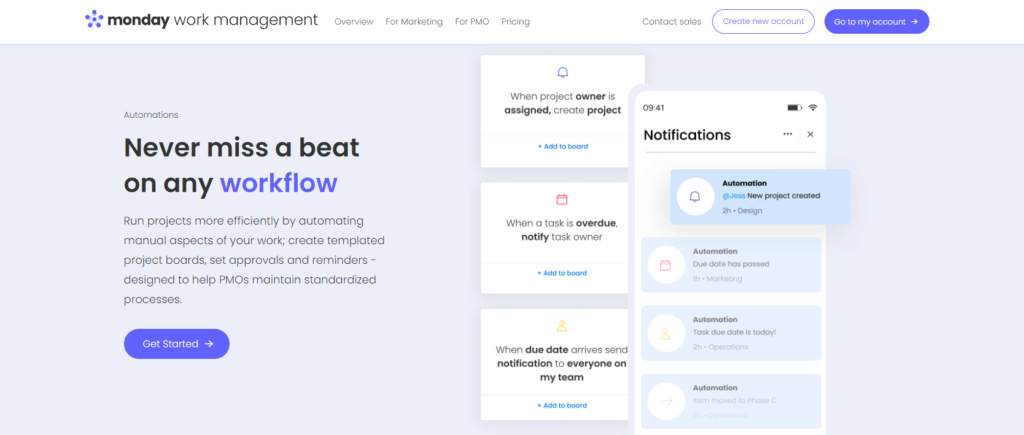
ClickUp offers a highly flexible and feature-rich solution for PMOs that require deep project tracking and team collaboration. With built-in time tracking, goal-setting, and workload management, ClickUp helps PMOs optimize resource allocation and monitor team productivity in real time.
The platform’s hierarchical structure allows for detailed organization of projects, tasks, and subtasks, giving PMOs full control over project execution. Additionally, ClickUp provides extensive automation options, real-time dashboards, and customizable reports, making it an excellent choice for organizations managing complex project portfolios.
Top Benefits & Features:
- Hierarchical structure for deep project tracking (Spaces → Folders → Lists → Tasks → Subtasks).
- Built-in time tracking for monitoring work effort and optimizing resource allocation.
- Robust reporting tools, including custom dashboards and real-time analytics.
- Goal setting & OKRs to align project objectives with business strategies.
- Task automation to streamline workflows and eliminate repetitive work.
- Workload management & capacity planning for effective team distribution.
- Extensive integrations, including Trello, Zoom, Google Drive, and GitHub.
Why Choose ClickUp for Your PMO?
ClickUp is one of the most versatile project management tools available, making it a great fit for dynamic PMOs managing diverse projects. It provides a comprehensive suite of tools that caters to different work styles, from Agile and Scrum to traditional Waterfall methodologies. Its detailed task tracking, powerful automation, and deep analytics make it a strong contender for organizations that require granular project visibility and control.
Considerations:
- ClickUp’s extensive features can be overwhelming for beginners, requiring onboarding for teams unfamiliar with complex project management tools.
- The mobile app experience is less refined than the desktop version, which may impact accessibility for on-the-go project managers.
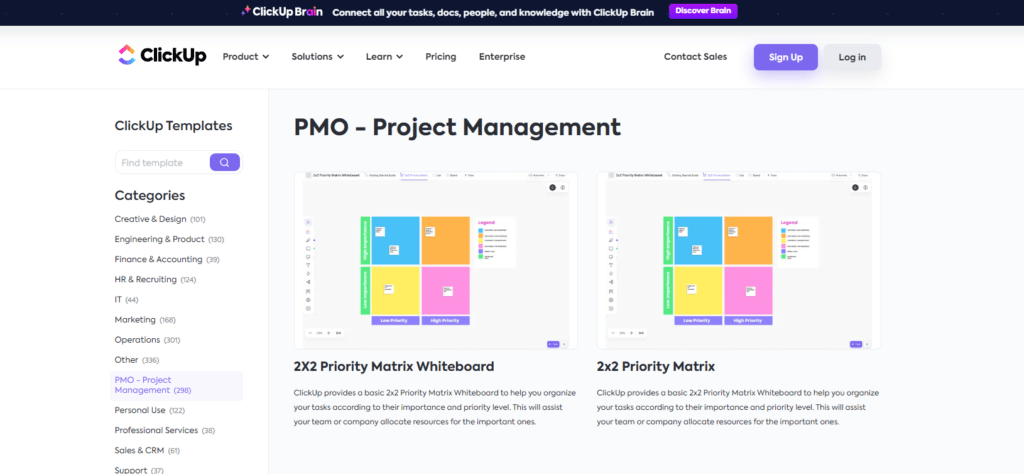
Teamwork.com is an excellent choice for PMOs managing client projects and external stakeholders. It provides advanced features like budget tracking, invoicing, and client collaboration tools, making it ideal for service-based businesses and agencies.
One of Teamwork.com’s strengths is its resource scheduling and workload management tools, ensuring that PMOs can efficiently allocate resources across multiple projects. It also integrates with various third-party tools like HubSpot, Google Drive, and QuickBooks, making it a strong contender for organizations that require seamless communication between internal teams and external clients.
Top Benefits & Features:
- Client management tools, including role-based permissions and project visibility settings.
- Advanced time tracking with billable hour tracking for agencies and service-based teams.
- Budget tracking and invoicing to manage project finances efficiently.
- Integrated document sharing and project collaboration tools.
- Workload balancing & resource scheduling to prevent over-allocation.
- Seamless integration with HubSpot, Google Drive, QuickBooks, and more.
Why Choose Teamwork.com for Your PMO?
Teamwork.com is specifically designed for businesses that manage client-based projects, such as marketing agencies, consulting firms, and service providers. It offers robust billing, time tracking, and budget control features, making it easier to track project profitability. For PMOs that need external stakeholder collaboration, Teamwork.com provides secure access controls that allow clients to view progress without interfering with internal workflows.
Considerations:
- While excellent for client-based project management, Teamwork.com may not be as feature-rich in portfolio management as monday.com or ClickUp.
- Some advanced financial features require premium plans, making it a more significant investment for small teams.
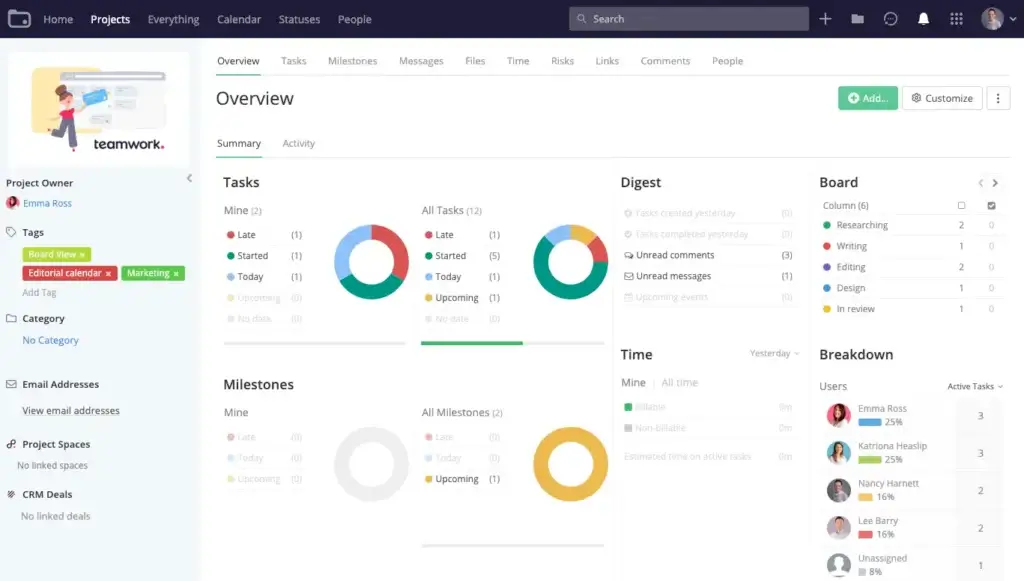
Which Project Management Tool is Best for Your PMO?
Each software offers unique strengths, so the best choice depends on your PMO’s specific needs:
| Feature | monday.com | ClickUp | Teamwork.com |
| Customization & Workflow Automation | ⭐⭐⭐⭐⭐ | ⭐⭐⭐⭐ | ⭐⭐⭐ |
| Portfolio Management | ⭐⭐⭐⭐⭐ | ⭐⭐⭐⭐ | ⭐⭐⭐ |
| Resource Management | ⭐⭐⭐⭐ | ⭐⭐⭐⭐⭐ | ⭐⭐⭐⭐ |
| Time Tracking & Workload Management | ⭐⭐⭐ | ⭐⭐⭐⭐ | ⭐⭐⭐⭐⭐ |
| Client Collaboration | ⭐⭐ | ⭐⭐ | ⭐⭐⭐⭐⭐ |
| Best For | Large teams, customizable workflows | Scalable project tracking, data-driven teams | Agencies, service-based companies |
- If your PMO needs a flexible, highly visual, and automation-rich platform, monday.com is the best option.
- For teams requiring in-depth task tracking, goal setting, and customizable workflows, ClickUp is a strong contender.
- If your PMO manages external client projects with billing and time tracking needs, Teamwork.com is the top choice.
By evaluating your PMO’s specific requirements, whether it’s portfolio management, automation, or client collaboration, you can select the right tool that aligns with your project goals and drives long-term success.
Conclusion
A Project Management Office (PMO) plays a critical role in ensuring project alignment, efficiency, and strategic success within an organization. To effectively manage multiple projects, optimize resource allocation, and enhance collaboration, choosing the right project management software is essential.
After comparing monday.com, ClickUp, and Teamwork.com, it’s clear that each platform offers unique advantages depending on your PMO’s needs:
- monday.com is the best choice for organizations that need highly customizable workflows, automation, and real-time dashboards to track multiple projects with ease.
- ClickUp stands out as a versatile, all-in-one solution with deep project tracking, automation, and reporting capabilities, making it ideal for data-driven teams managing complex projects.
- Teamwork.com is the top option for PMOs handling client-based projects, offering built-in budget tracking, invoicing, and time management features to streamline external collaboration.
Which One Should You Choose?
Your decision should be based on your PMO’s core priorities:
✅ Need a user-friendly, automation-driven platform for portfolio management? → Go with monday.com.
✅ Managing multiple teams with complex workflows and in-depth reporting needs? → ClickUp is your best bet.
✅ Running a service-based business that requires strong client collaboration tools? → Teamwork.com is the right fit.
No matter which tool you choose, implementing the right project management software will empower your PMO to standardize processes, enhance visibility, and drive successful project outcomes. By leveraging the right technology, your organization can stay agile, organized, and aligned with strategic business goals, ensuring long-term growth and efficiency in project management.
For those seeking further insights into the best software options tailored to their unique business requirements, additional information can be found at Top Project Management Software. This resource provides a comprehensive overview, helping businesses make well-informed choices in their quest for the ideal workflow management solution.
FAQs
1. What are the key differences between a project management office and a project manager’s responsibilities?
A project manager is responsible for executing individual projects, including planning, resource allocation, and risk management. In contrast, a centralized office oversees multiple projects, ensuring standardization, governance, and strategic alignment across the organization. While a project manager focuses on day-to-day execution, the broader entity provides methodologies, best practices, and oversight to drive consistency and efficiency.
2. How does a project management office contribute to achieving a company’s strategic goals?
By aligning projects with business objectives, this centralized unit ensures that every initiative adds value to the company’s long-term vision. It helps prioritize high-impact projects, allocate resources efficiently, and track performance using key performance indicators (KPIs). The structured approach enhances decision-making, risk mitigation, and financial oversight, ensuring all initiatives support the company’s growth strategy.
3. What are the common challenges faced when establishing a structured project management entity, and how can they be overcome?
Some common challenges include resistance to change, lack of executive buy-in, and difficulty in integrating standardized processes. Overcoming these obstacles requires clear communication of benefits, securing leadership support, and implementing incremental process improvements to ensure smooth adoption. Providing training, setting realistic expectations, and leveraging automation tools can also ease the transition.
4. How does a structured project management unit adapt to changes in Agile or Scrum methodologies?
An effective system must be flexible and adaptable to different project management methodologies. It can support Agile and Scrum by offering lightweight governance, enabling cross-team collaboration, and facilitating Agile frameworks like Scrum ceremonies, backlog prioritization, and sprint planning. The focus is on balancing standardized reporting and autonomy to empower teams while maintaining organizational alignment.
5. What metrics are commonly used to measure project success?
Several performance indicators help track project outcomes, including:
-
On-time delivery – Ensuring projects meet deadlines.
-
Budget adherence – Monitoring project costs against forecasts.
-
Resource utilization – Evaluating workforce efficiency.
-
Stakeholder satisfaction – Measuring client and executive feedback.
-
Risk mitigation – Tracking the effectiveness of issue resolution.
Using data-driven insights, teams can refine their strategies and improve future project performance.
6. How can a structured project management unit improve communication and collaboration among teams?
Implementing centralized communication platforms, standardized reporting, and collaborative tools fosters seamless interaction across teams. Regular meetings, status updates, and shared dashboards ensure transparency, while automation streamlines task management. Encouraging a culture of open feedback and providing teams with clear guidelines and documentation also enhances efficiency and alignment.
7. What role does a project management office play in risk management across multiple projects?
Effective oversight helps identify, assess, and mitigate risks before they escalate. By maintaining risk registers, contingency plans, and proactive monitoring, teams can address potential issues early. A structured framework ensures that risk assessment methodologies are consistently applied, improving response times and minimizing project disruptions.
8. How does a structured project management unit integrate with other departments within an organization?
By establishing cross-functional workflows, this entity bridges the gap between departments such as finance, IT, HR, and operations. Standardized reporting ensures that executives receive accurate insights, while dedicated project liaisons foster collaboration between teams. The integration of automated workflows and cloud-based tools enables seamless information sharing and decision-making.
9. What are the best practices for scaling a structured project management entity in a growing organization?
Scaling requires a phased approach that includes:
-
Defining clear objectives aligned with company growth.
-
Standardizing processes while allowing flexibility for different teams.
-
Investing in project management software to automate workflows.
-
Training employees on best practices and methodologies.
-
Regularly reviewing KPIs to adjust strategies based on performance insights.
A scalable structure ensures continued efficiency, adaptability, and strategic alignment as the company expands.
10. How can technology and software tools enhance project oversight and efficiency?
Modern cloud-based project management tools provide real-time dashboards, automated reporting, and AI-driven insights. Features like Gantt charts, task dependencies, time tracking, and resource allocation enhance project visibility. Integrating collaboration tools, automation workflows, and machine learning analytics helps streamline operations, reduce manual workload, and improve decision-making.
11. What is PMO vs PMP?
PMO (Project Management Office) is a department or function within an organization that establishes project management standards, methodologies, and governance across multiple projects. PMP (Project Management Professional) is a certification offered by the Project Management Institute (PMI) that validates an individual’s expertise in managing projects using industry best practices. While a PMO ensures project consistency and alignment with business goals, a PMP-certified professional is skilled in executing projects effectively.
12. What does PMO mean?
PMO stands for Project Management Office, a centralized unit that oversees project execution, ensures consistency, and supports organizational strategy by defining methodologies, tracking performance, and optimizing resource allocation.
13. What does a project management office do?
A Project Management Office serves as the backbone of structured project execution by:
-
Implementing standardized processes to improve efficiency.
-
Managing project portfolios to align with business goals.
-
Providing tools, training, and support for project managers.
-
Ensuring budget adherence and risk mitigation across projects.
-
Enhancing collaboration between departments for smoother execution.
14. Is PMO a good career?
Yes, working in a Project Management Office is a rewarding career with high demand in industries like IT, healthcare, construction, and finance. Professionals in this field develop skills in strategic planning, risk management, resource allocation, and leadership. The role offers competitive salaries, career advancement opportunities, and exposure to high-impact projects, making it an excellent path for those interested in project management and organizational leadership.




